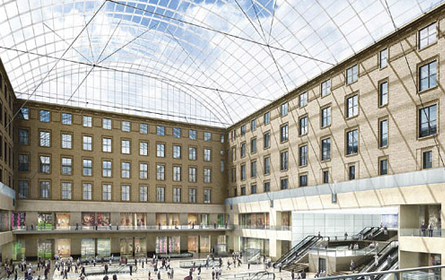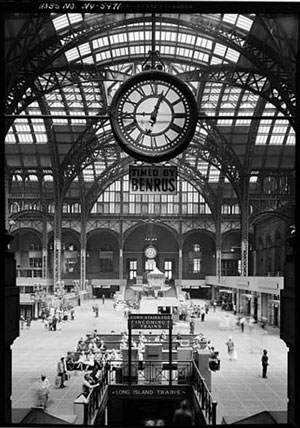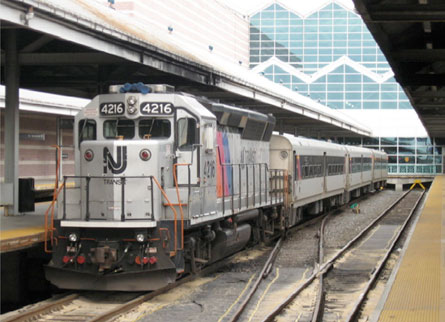Moynihan Station Moves Forward

Religious rhetoric often seems to find its way into discussions of Moynihan Station, which makes a good deal of sense if one subscribes to the notion that, in the historical schema of civic architecture, grand cathedrals were replaced by train terminals and post offices. Moynihan Station involves both: Its most current iteration calls for the construction of a railroad station inside of the eastern half of Farley Post Office, which would then be known as Moynihan Station.
Speaking of the project that would come to bear his name, the late U.S. Sen. Daniel Patrick Moynihan intoned at a 2002 press conference: "In the old time, you arrived at Pennsylvania Station at the train platform. You went up the stairs to heaven. Make that Manhattan. And we shall have it again. Praise all."
The old time, of course, referred to the era of old Pennsylvania Station: the Beaux-Arts masterpiece designed by McKim, Meade & White in 1910, where Moynihan sold newspapers and shined shoes as a boy fresh to the city from Tulsa, Okla. It was replaced by the new Penn Station in the mid 1960s, an act that the critic Lewis Mumford then characterized as "irresponsible public vandalism," and is now seen as a catalyst for the architectural preservation movement in the U.S. The two stations are so drastically different that the Yale architecture professor Vincent Scully once compared the old to the new by saying, "One entered the city like a god; one scuttles in now like a rat."
A Return to Grandeur

Moynihan's plan to restore Penn Station's greatness -- which has been stalled so long that it's hard not to see the whole thing as some sort of civic penance -- has always aimed to turn the Farley Post Office across Eighth Avenue -- a McKim, Meade, and White Beaux-Arts building designed to match its former neighbor -- into a grand railroad station befitting New York. Over the years, the proposal has called for a variety of anchor tenants, including Amtrak, New Jersey Transit and the Long Island Railroad, and a litany of additional components such as a relocated Madison Square Garden, 850,000 square feet of commercial space, 5.5 million square feet of towering office space, and much more. Despite all of the permutations, state funds, private money, a few environmental impact statements, and even an engraved marble cornerstone that has gone missing, the project never managed to get off (or into) the ground.
Earlier this month, Gov. David Paterson and Sen. Chuck Schumer started up the Moynihan chatter once again. After six months of negotiations with Amtrak, parties reached a preliminary agreement for the company to relocate its operations to the Farley Post Office, if a train station were to be built there. That move improved, but by no means guaranteed the prospects for federal stimulus funds for the construction needed to turn the post office into Moynihan Station.
The long holdup has nothing to do with a lack of support. Since Moynihan started to champion Amtrak's suggestion that the Farley Post Office serve as New York City's new train station in 1993, civic groups and elected officials have crowded on board as though the plan was Noah's ark. At times, perhaps, all this enthusiasm has caused problems. When Assembly Speaker Sheldon Silver shot down one of the biggest iterations of the project, known as Plan B, in 2006, it was not because he was opposed to the development, but because he thought one of the cooks in the kitchen, the Empire State Development Corp., wasn't doing its job well.
One Step at a Time
The real trouble, though, has been getting all of the project's financial ducks in a row, a dilemma that this latest try seems eager to best with a piecemeal funding strategy. The New York Observer reported: "One official involved with the project called this approach moving beyond 'the Big Bang theory,' the method of executing everything at once, which has failed so many times before."
The current iteration of the Moynihan station project is expected to cost between $1.1 billion and $1.5 billion. There is already more than $200 million in federal funding earmarked for the project and on September 15, the state applied for nearly $100 million for necessary below-ground work through a stimulus-bill backed program called Transportation Investment Generating Economic Recovery or TIGER, a discretionary grant directly overseen by the Obama administration.
In addition, "[State] officials are planning a second application for a to-be-determined amount of money from the $8 billion set aside in the stimulus for high-speed rail projects," the Observer reported. It cited a preliminary application that the Paterson administration put forward earlier this year seeking nearly $400 million of those high-speed rail dollars.
Of course, given the current economic situation and the money's relatively well-publicized availability, there is stiff competition between state transportation departments all around the country for both the TIGER and high-speed rail funds.
At this point, it seems like if any those dollars make it to New York, it will be on a wing and a prayer, which, given all that has been written about Moynihan Station, is perhaps fitting.
Tunnel Vision

The largest transit public works project in the country held its groundbreaking ceremony on the western shore of the Hudson River just two months ago. The Mass Transit Tunnel, the venture's third name in 15 years, is a fully-funded $8.7 billion trans-Hudson rail link connecting the west side of Manhattan to northern New Jersey.
Gotham Gazette on the Waterfront

.........................
Neglected National Parkland
Our parks columnist explores the national parkland along the New York Harbor -- an area most New Yorkers have never heard of.
.........................
The city has created a new plan for the ball fields on Randall's Island. Critics, though, are calling foul.
.........................
As planners and developers eye the water's edge, are grassroots and community advocates losing their say?
.........................
Its many powerful proponents, including the governors of New York and New Jersey, numerous elected officials from both states, the Federal Transit Administration, the Port Authority of New York and New Jersey, the New Jersey Turnpike Authority -- all of whom have contributed funding to the project -- as well as countless advocacy groups assert that the new tunnel will speed commutes, ease congestion, create jobs and provide environmental benefits.
As is to be expected with a project of this size, the plan has its critics, too. Some of the more vocal naysayers meet on the fourth Wednesday of every month in Lower Manhattan under the moniker the Regional Rail Working Group. These dissenters don't dispute the need for a second commuter rail tunnel under the Hudson. They do, however, believe the current plan isn't worth its price tag, and they're telling everyone they can, including Obama Administration appointees.
Why Another Tunnel?
In the past 25 years, the number of people passing through the existing two-track, century-old rail tunnel connecting northern New Jersey to Penn Station has more than quadrupled, soaring from roughly 10 million in 1984 to about 44 million today. Every hour, 23 New Jersey Transit trains pass through the old tunnel during rush hour, and as any regular rider can attest, that's a recipe for delays.
While Metro-North commuters are graced with an on-time performance rate of around 97 percent, their New Jersey bound cohorts on the Northeast Corridor line have a rush hour performance of 85.09 percent, according to the Asbury Park Press.
In addition to nearly doubling capacity, the new tunnel will ease the minds of many safety-minded commuters and elected officials, pull nearly 22,000 vehicles off the road, reduce greenhouse gases emitted by 67,000 tons, and generate and sustain 6,000 jobs through the construction phase and 44,000 jobs when completed.
So What's the Problem?
George Haikalis, president of the Institute for Rational Urban Mobility, a New York City-based nonprofit transportation group, and chair of the Regional Rail Working Group, wants a new tunnel. He wants better transit, cars off the roads, greenhouse gases reduced and safety concerns ameliorated. He just thinks there's a better way than the current iteration of the Mass Transit Tunnel.
Haikalis asks, "If we're going to spend nearly $10.5 billion on this project, I'd like to make it's as good as can be. Isn't that commonsense?" His significantly higher cost estimate includes the rehabilitation of the Hackensack River's Portal Draw Bridge -- an "unfunded, but absolutely necessary" $1.7 billion link to the tunnel's New Jersey entrance.
He and the working group believe that the tunnel, which as now conceived ends at 34th Street and Seventh Avenue about 180 feet below ground and connects to Penn Station by a series of escalators, should link directly with the tracks there and continue on to Grand Central Station. "It would be the mother of all train station connections," he says, adding that it would be "the obvious choice for regional rail advocates."
For Haikalis, Penn Station should act as a "through station" for New Jersey Transit, as it does for Amtrak, with another stop at Grand Central and then a turnaround at a rail yard somewhere north or east of the city. Then regional connectivity would be a reality -- a simple transfer, not two trains and an uptown then cross-town subway ride -- could get one from Trenton to New Haven.
And to some extent most agree that Haikalis and the Regional Rail Working Group are right. New Jersey Transit's press release for the groundbreaking ends, "The project has been designed to allow for expansion in Manhattan to the east in the future as conditions and funding permit."
Neysa Pranger of the Regional Plan Association said, "We absolutely believe the tunnel should continue to Grand Central Station, but that's a second stage. We certainly don't think the current environmental impact statement should be ripped up."
And that's the real sticking point. The Regional Rail Working Group's vision centers on a tunnel that comes into Penn Station at a shallower depth than the current version in order to physically connect the new tracks with already existing ones, which would facilitate through-travel, smoother transfers and shorten the time it takes commuters to reach the surface, which Haikalis estimates to be an additional four or five minutes. It also requires interoperability between Metro-North trains and tracks and New Jersey Transit trains and tracks at Grand Central Station. Although much of this would not require a return to the drawing board -- this alternative was put forth in a 2003 tunnel plan -- it would require a great deal of cooperation between Metro-North and New Jersey Transit, as well as a new environmental impact statement, which would negate most, or all, of the already-secured $8.7 billion for the project. In the minds of everyone but the most optimistic, then, the plan will surely proceed as is.
Mr. Haikalis Goes to Washington
"People have said about my efforts, 'The perfect is the enemy of the good,'" Haikalis said to me in a recent phone conversation. "Well, I think that's a stupid way to discuss something, and we're not talking about perfect. We're talking about what's better. Much better," and with that in mind, he and the Regional Rail Working Group are continuing on their quest.
"We had back-to-back meetings with President [George] Bush's Railroad and Transit people about this, we've already met with Obama's Deputy Secretary for Transit Policy, and we have a pending appointment with the Federal Railroad Administrator next month. Whether the new administration will be willing to challenge states, and demand the most for their money, we'll see," he said, sounding quite confident.
Peter Rogoff, President Obama's Federal Transit Administrator attended the Mass Transit Tunnel's groundbreaking, where he said, "The Obama administration is thrilled to partner with New Jersey to build this truly transformational investment. It will improve the lives of thousands by shortening their commute. And best of all, it will create jobs now. The Obama administration is committed to seeing this project through to its completion."
And although that makes it sound like plans for the Mass Transit Tunnel won't be changed any time soon, Haikalis and his colleagues are convinced that history will judge them favorably, and if things aren't changed, commuters of the future will have another reason to shake their fists.




